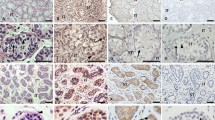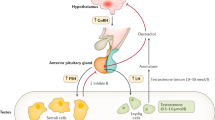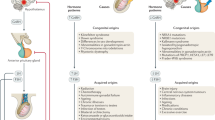Abstract
TESTICULAR androgen is the principal stimulus for spermatogenesis1. Androgens alone are capable of maintaining spermatogenesis in hypophysectomised rats when treatment is begun immediately following hypophysectomy2. Following posthypophysectomy regression of the seminiferous epithelium, however, neither luteinising hormone (LH) nor androgen given alone is capable of initiating spermatogenesis when the same dose and time schedule is used for the treatment. Follicle stimulating hormone (FSH) has to be given together with LH or androgen to effectively restore spermatogenic activity1. This difference between maintenance (treatment started immediately after hypophysectomy) and initiation (treatment started after regression of the germinal epithelium) of spermatogenesis, has been known for more than 30 yr (ref. 3), but no data have been provided which could explain this phenomenon.
This is a preview of subscription content, access via your institution
Access options
Subscribe to this journal
Receive 51 print issues and online access
$199.00 per year
only $3.90 per issue
Buy this article
- Purchase on Springer Link
- Instant access to full article PDF
Prices may be subject to local taxes which are calculated during checkout
Similar content being viewed by others
References
Steinberger, E., Phys. Rev., 51, 1 (1971).
Walsh, E. L., Cuyler, W. K., and McCullagh, D. R., Am. J. Physiol., 107, 508 (1934).
Nelson, W. D., Cold Spring Harb. Symp. quant. Biol., 5, 123 (1937).
Hansson, V., et al., Nature new Biol., 246, 56 (1973).
Hansson, V., et al., Nature, 250, 387 (1974).
French, F. S., and Ritzén, E. M., Endocrinology, 93, 88 (1973).
Hagenäs, L., Ritzén, E. M., French, F. S. & Hansson, V., J. Steroid Biochem., 5, 382 (1974).
Hagenäs, L., et al., Molec. cell. Endocrinol. (in the press)
Vernon, R. G., Kopec, B., and Fritz, I. P., Molec. cell. Endocrinol., 1, 167 (1974).
Ritzén, E. M., Hagenäs, L., Svan, H., French, F. S., and Hansson, V., Pediatric Res. (in the press).
Ritzén, E. M., French, F. S., Weddington, S. C., Nayfeh, S. N., and Hansson, V., J. biol. Chem., 249, 6597 (1974).
Dorrington, J. H., Vernon, R. G., and Fritz, I. B., Biochem. biophys. Res. Commun., 46, 1523 (1972).
Dorrington, J. H., and Fritz, I. B., Endocrinology, 94, 395 (1974).
Means, A. R., and Huckins, C., in Hormone Binding and Target Cell Activation in the Testis (edit. by Means, A. R., and Dufau, M. L.), (Plenum, New York, 1974).
Author information
Authors and Affiliations
Rights and permissions
About this article
Cite this article
WEDDINGTON, S., HANSSON, V., RITZEN, E. et al. Sertoli cell secretory function after hypophysectomy. Nature 254, 145–146 (1975). https://doi.org/10.1038/254145a0
Received:
Issue Date:
DOI: https://doi.org/10.1038/254145a0
This article is cited by
Comments
By submitting a comment you agree to abide by our Terms and Community Guidelines. If you find something abusive or that does not comply with our terms or guidelines please flag it as inappropriate.



